Results showed that feed intake increases in line with higher inclusion rates of the Calanus finmarchicus hydrolysate
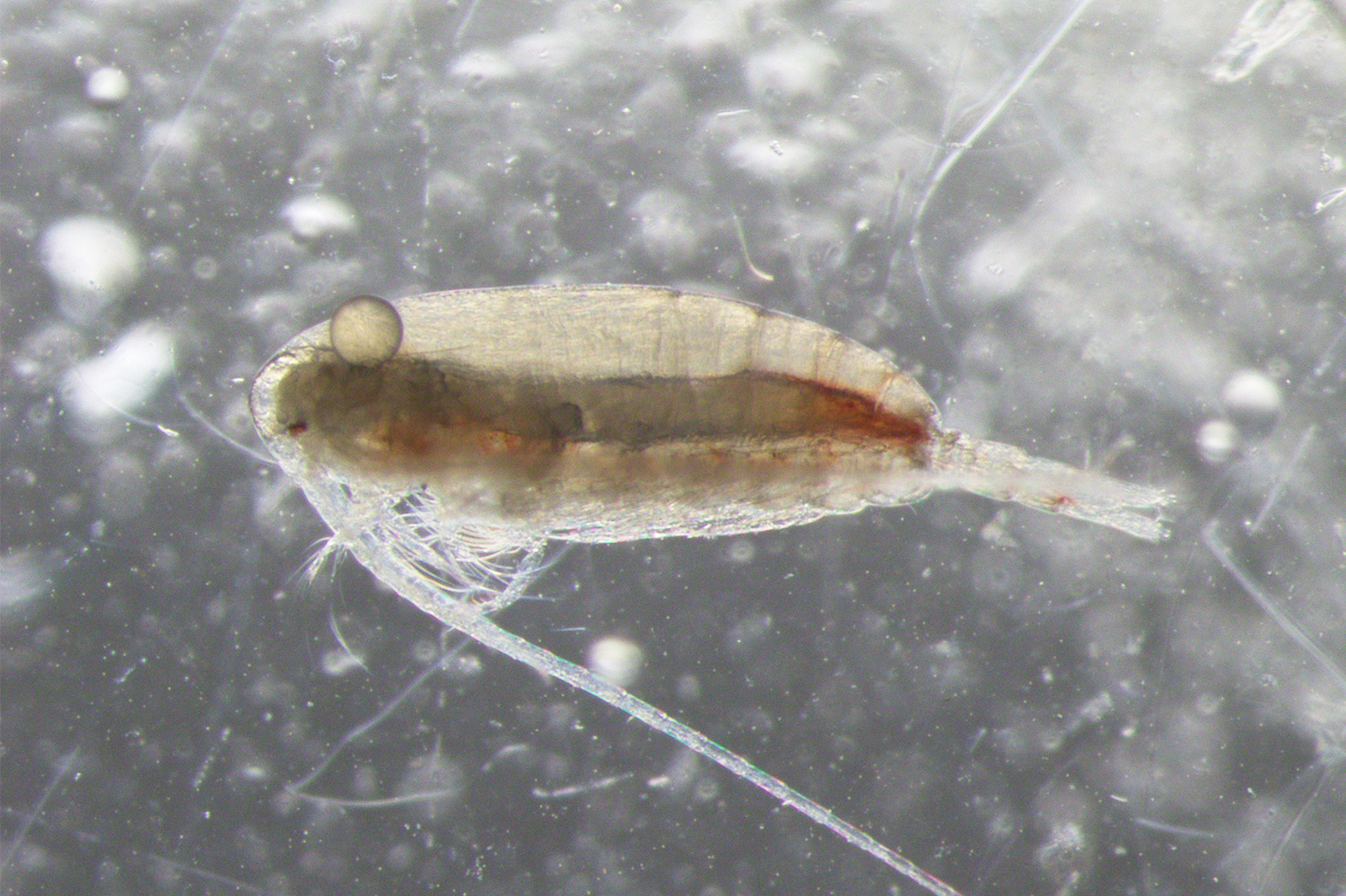
A general concern with using mainly plant ingredients in aquaculture diets is the apparent lack of attractiveness and palatability for carnivorous fish and crustaceans. Shrimp are chemosensory feeders, using systems of olfaction and chemoreception when locating and consuming food. The inclusion of attractants that activate the chemosensory systems is common to increase the attractiveness of diets with high plant protein content.
Natural chemoattractants for shrimp are often marine ingredients rich in free amino acids, nucleotides, nucleosides, quaternary ammonium compounds, phospholipids, and biogenic amines, which are recognized by the chemosensory system of aquatic animals when locating and ingesting feed materials. In addition, dietary inclusion of marine ingredients in water-soluble form (e.g., protein hydrolysates) has been found especially attractive and palatable.
Zooplankton are a natural food source for wild shrimp as they grow from omnivore larvae to the more carnivorous post-larval stages. A novel resource of zooplankton products with potential for feed applications is Calanus finmarchicus, a copepod species in the northern Atlantic Ocean with an annual biomass production estimated at 290 million tons. This significant production combined with a suitable nutrient composition make this copepod species a significant and relevant resource for both human consumption and animal nutrition. One of the novel products made from C. finmarchicus is a low molecular weight protein hydrolysate, recently determined to increase fish growth.
This article – summarized from the original publication (Bøgwald, I. et al. 2024. Effect of Calanus finmarchicus Hydrolysate Inclusion on Diet Attractiveness for Whiteleg Shrimp (Litopenaeus vannamei). Fishes 2024, 9(4), 134) – reports on research to evaluate the potential chemoattractive effects of C. finmarchicus hydrolysate as a supplement in L. vannamei shrimp feed formulations by quantifying the effect of this novel ingredient on the feeding behavior and intake levels of Pacific white shrimp.
Intensively cultured Paraclanid copepods for small tropical marine fish larvae?
Study setup
Diet attractiveness was evaluated in a 24-day feeding trial with L. vannamei shrimp by measuring the intake of 12 diets with various levels of fishmeal, Calanus hydrolysate (CH), and krill meal (KM). The copepods were harvested and processed by Calanus AS (Tromsø, Norway), and the krill meal was purchased from a commercial producer.
Diets were produced, and the trial was performed using a recirculating aquaculture system (RAS) at the Matís Aquaculture Research Station (MARS) (Reykjavik, Iceland), with L. vannamei PL20 procured from White Panther Produktion GmbH (Germany). Shrimp (n = 720; 3.67 ± 0.01 grams) were stocked into 36 tanks at 20 animals per tank.
The experimental diets were formulated as isonitrogenous (38 percent crude protein), isolipidic (7 percent crude lipids), and isoenergetic (17.6 MJ/Kg). Inclusion levels of certain ingredients were adjusted to ensure equivalent levels of nutrients in the diets. Twelve diets were produced, of which half received a low fishmeal content (10 percent), and the other half had a high fishmeal content (20 percent). For each of the six diets in the two groups, one control diet had no test ingredients (compensated by wheat gluten meal), three had varying concentrations of CH (2, 4 and 6 percent), and two had varying concentrations of KM (2 and 3 percent).
Ingredient inclusion rates were chosen on the basis of the different dry matter contents of CH (53.3 percent) and KM (91.6 percent). The 12 experimental diets were fed three times per day for 24 days. Diets were switched every day from one tank to another, and every tank thus received each diet twice at the end of the trial. For detailed information on diet preparation, animal husbandry, data collection and analyses, refer to the original publication.
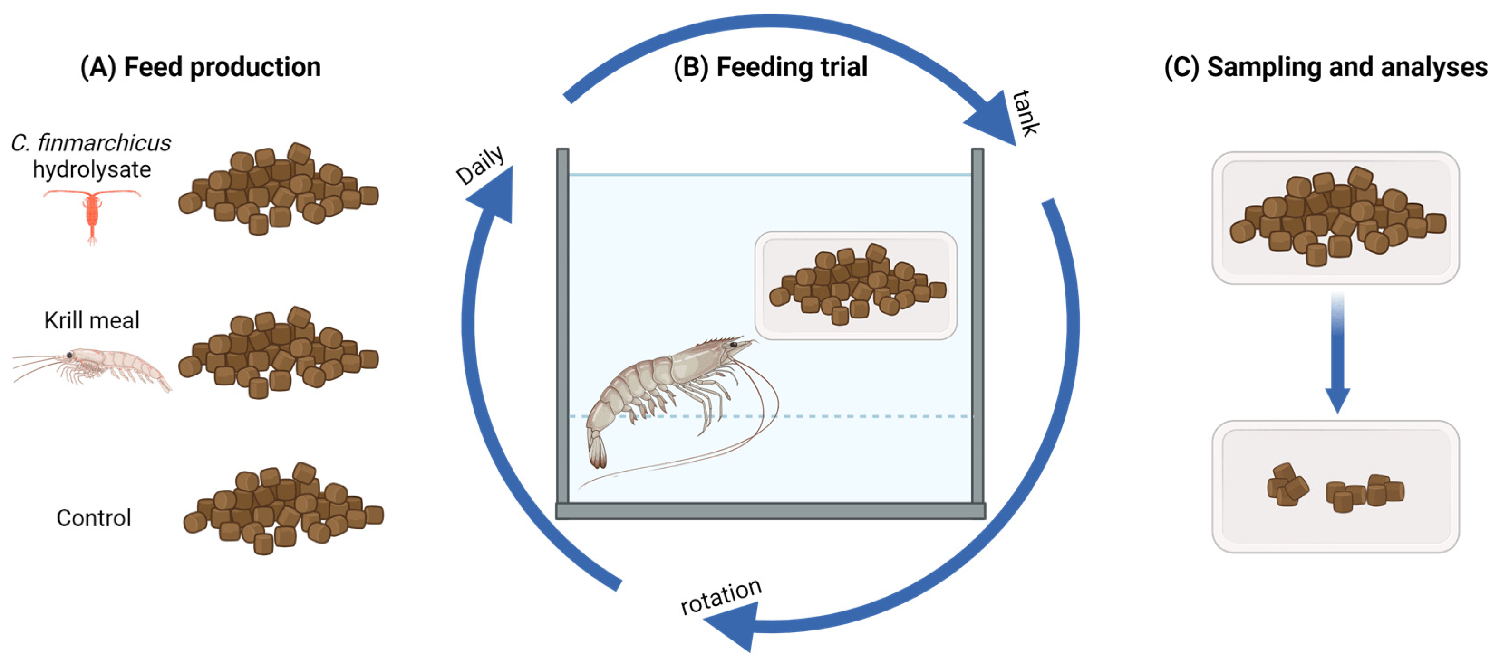
Results and discussion
The test shrimp fully accepted all the diets from the start (mean body weight 3.67 grams) and throughout the experiment until the end (mean body weight 10.46 grams). The daily rotation study design of switching the diets to new tanks each day was also successful. This specific design excluded any potential tank bias in the study but also meant that only collective performance parameters could be measured beyond feed intake. All water quality parameters were well within acceptable ranges. Shrimp survival was 99.6 percent, the specific growth rate was 4.18 percent per day and the feed conversion ratio was 1.76.
The overall feed intake results were similar for both low and high fishmeal groups, wherein the intake of CH diets increased with higher inclusion rates, while diets with KM had an intermediate effect (Fig. 2). However, only the results in the high fishmeal group were statistically significant (Fig. 2B).
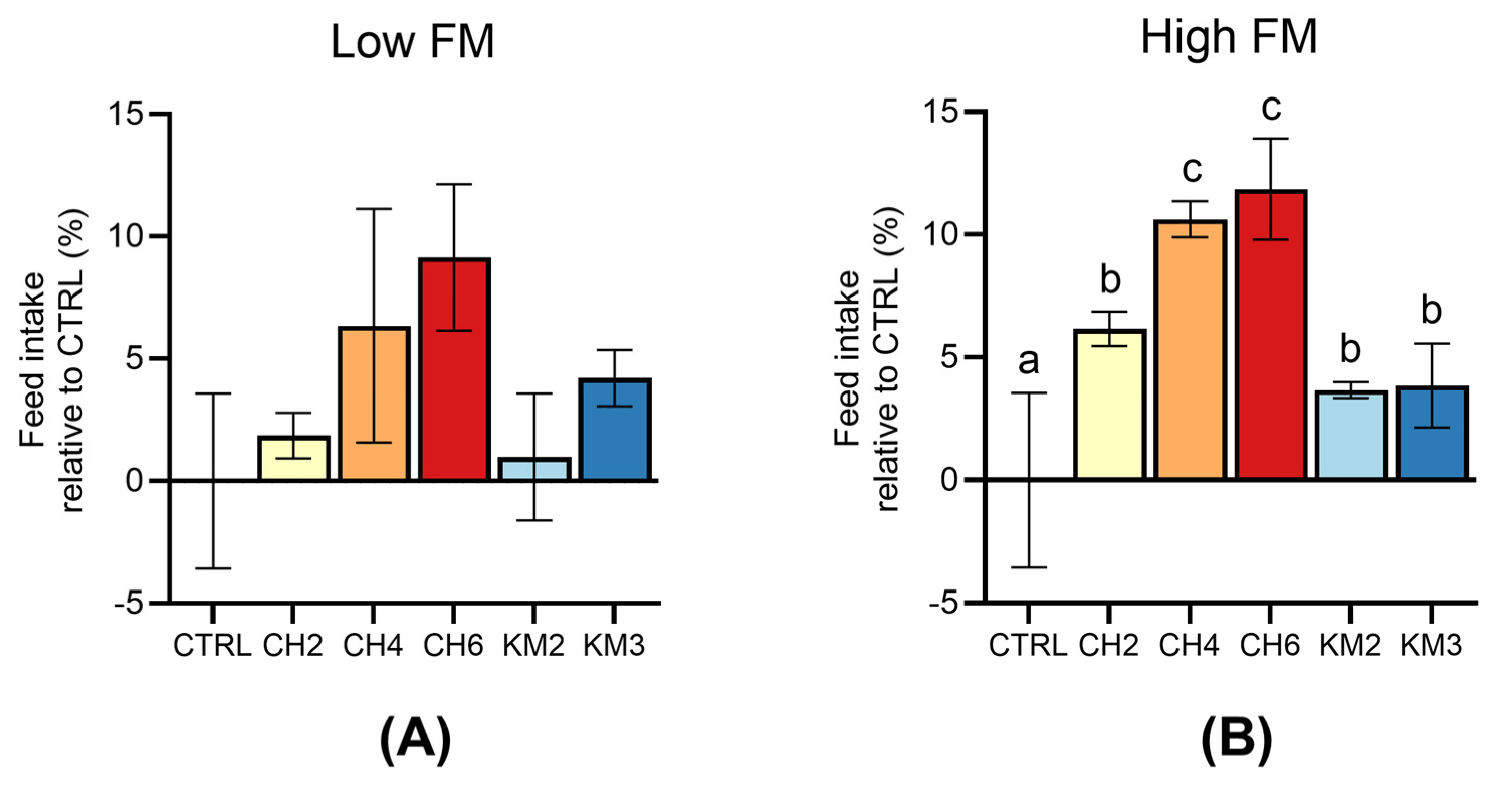
The observed effect in this study could stem from a combination of the chemoattractive content and the water-soluble nature of CH, which allows the leaching of the chemosensory compounds into the water surrounding the shrimp, leading to increased attractiveness and ultimately feed intake. Processing raw materials with enzymatic hydrolysis yields protein hydrolysates, which are soluble protein fractions abundant in chemoattractive substances, such as free amino acids, nitrogen-containing marine metabolites, and peptides. Low molecular weight peptides and metabolites have been found to be especially important for feed attractiveness and palatability, and approximately 87 percent of the protein in CH are free amino acids and peptides under 1000 Daltons (1.660 x 10−27 kg.) in molecular weight.
Combined data from low and high fishmeal groups show that the feed intake increased in line with the inclusion rates of both attractive ingredients (Fig. 3). Marine proteins known to enhance feed attractiveness and palatability for shrimp, such as squid and krill, are included at low dietary levels, often between 0.5 percent and 5 percent, sufficient to elicit positive feeding behavioral responses without too heavy an impact on formulation costs. Krill meal was included at 2 percent and 3 percent in the diets of this study, mimicking its typical commercial inclusion rates and also according to the levels found optimal in several studies.
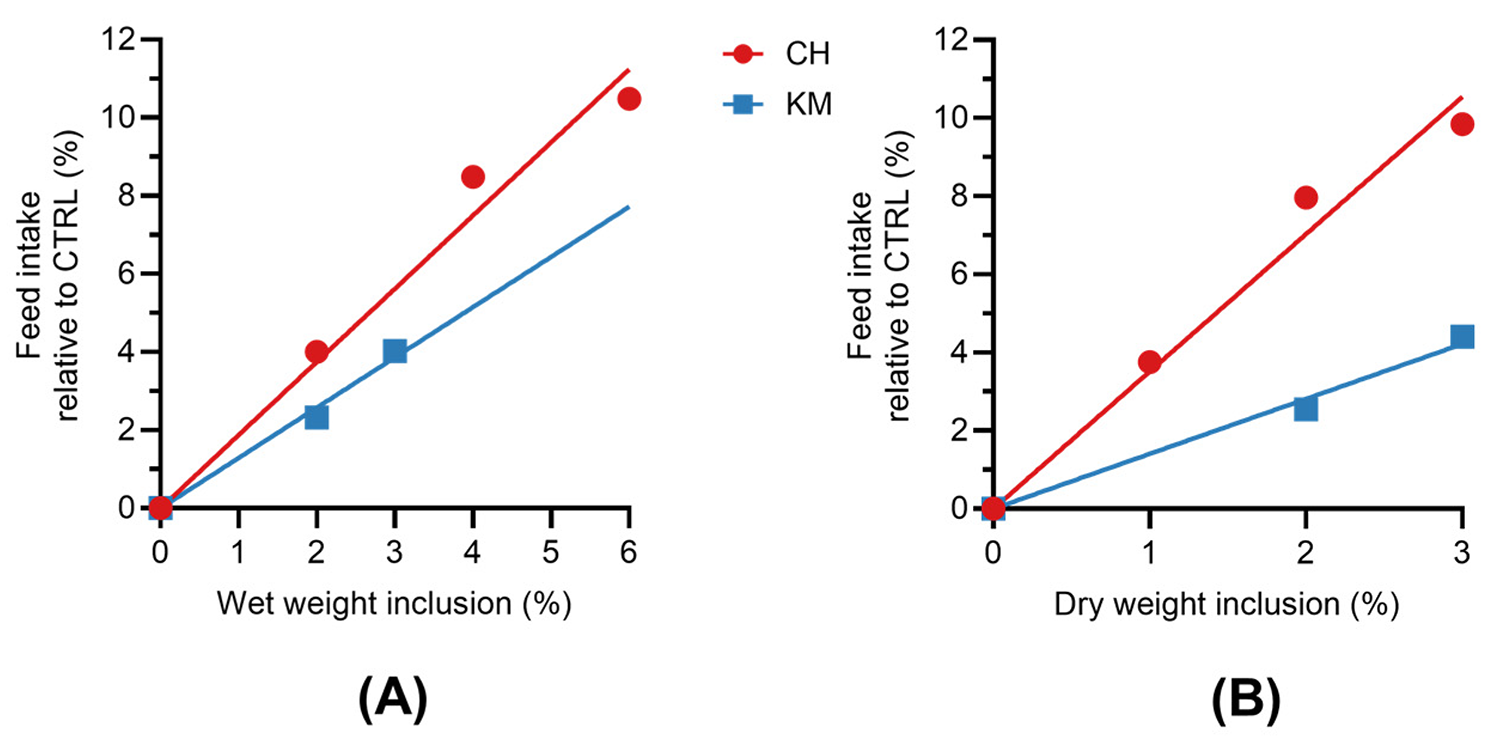
We compared the chemoattractant amino acids in the attractive ingredients looking for further answers as to why diets with CH showed higher attractiveness. The two most striking differences were found for the amino acids glycine and taurine, both of which were notably higher in CH than in KM on a dry matter basis. CH is especially rich in taurine, a neutral non-proteinogenic amino acid widely distributed in animal tissues, and the results of the study indicate that it is important for diet attractiveness. Plant proteins are generally deficient in taurine, possibly explaining part of their lower attractiveness and palatability.
In addition to increased feed intake, supplementation of taurine in diets for juvenile L. vannamei shrimp has been found to improve growth performance, metabolism, immunity, anti-oxidant capacity and intestinal health. For C. finmarchicus it has been reported that one of its major metabolites is betaine, which is a highly soluble glycine derivative with chemoattractive properties for both fish and shrimp.
On a final note, this study shows that products of both Arctic and Antarctic species are perfectly suited as ingredients for increased attractiveness of diets for a tropical species of shrimp. Increased feed intake should also mean reduced feed waste, thereby improving the efficiency and sustainability of shrimp farming practices by reducing the amount of unutilized feed, ultimately leading to cleaner wastewater and less negative environmental impacts from the industry. L. vannamei juveniles were used in this study, as most other comparable nutritional studies are carried out under controlled conditions at juvenile or post-larval stages.
Chemoattractant properties and optimal nutritional composition of feeds are also especially important in early life stages, wherein low feed intake and suboptimal growth can make shrimp more vulnerable to diseases and increase the risk of cannibalism.
Presently there are no other published studies on the effects of products from C. finmarchicus in shrimp feeds, and the promising results on chemoattraction presented here should motivate further exploration of the nutritional and functional properties of products from this novel raw material for shrimp aquaculture.
Perspectives
Our results showed that a novel protein hydrolysate from C. finmarchicus increased the attractiveness of formulated feeds for L. vannamei shrimp, wherein diets with CH inclusion showed higher feed intake compared with the negative control and diets with krill meal inclusion. Feed intake increased in line with higher inclusion rates, and the notably high chemoattractant properties of CH could be attributed to a combination of its water-soluble nature, low molecular weight peptides, and content of known chemoattractive amino acids.
Future studies on this hydrolysate should focus on the nutritional and functional properties, to investigate how the ingredient also can affect shrimp growth, survival and overall health.
Now that you've reached the end of the article ...
… please consider supporting GSA’s mission to advance responsible seafood practices through education, advocacy and third-party assurances. The Advocate aims to document the evolution of responsible seafood practices and share the expansive knowledge of our vast network of contributors.
By becoming a Global Seafood Alliance member, you’re ensuring that all of the pre-competitive work we do through member benefits, resources and events can continue. Individual membership costs just $50 a year.
Not a GSA member? Join us.
Author
-
Isak Bøgwald
Corresponding author
The Norwegian College of Fishery Science, UIT—The Arctic University of Norway, P.O. Box 6050, 9037 Tromsø, Norway; and Calanus AS, P.O. Box 808, 9258 Tromsø, Norway[111,110,46,116,105,117,64,100,108,97,119,103,111,98,46,97,46,107,97,115,105]
Tagged With
Related Posts
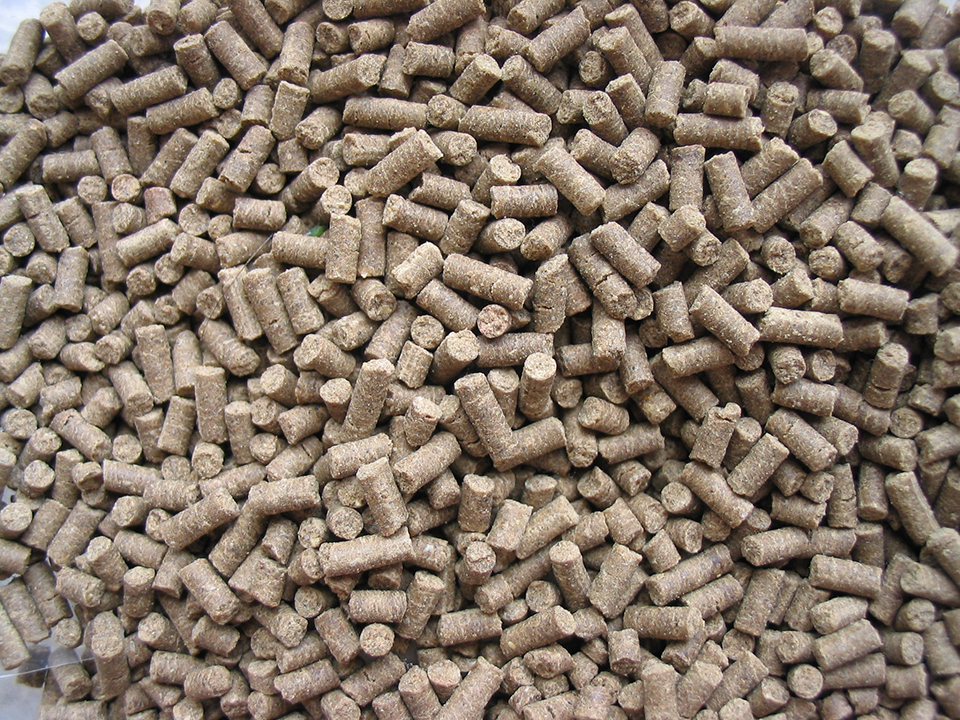
Aquafeeds
Chemoattraction in aquatic feed management
The value of chemical stimulants to shrimp farming will come via reproducible methods to evaluate the efficacy of chemoattractants and feeding stimulants.
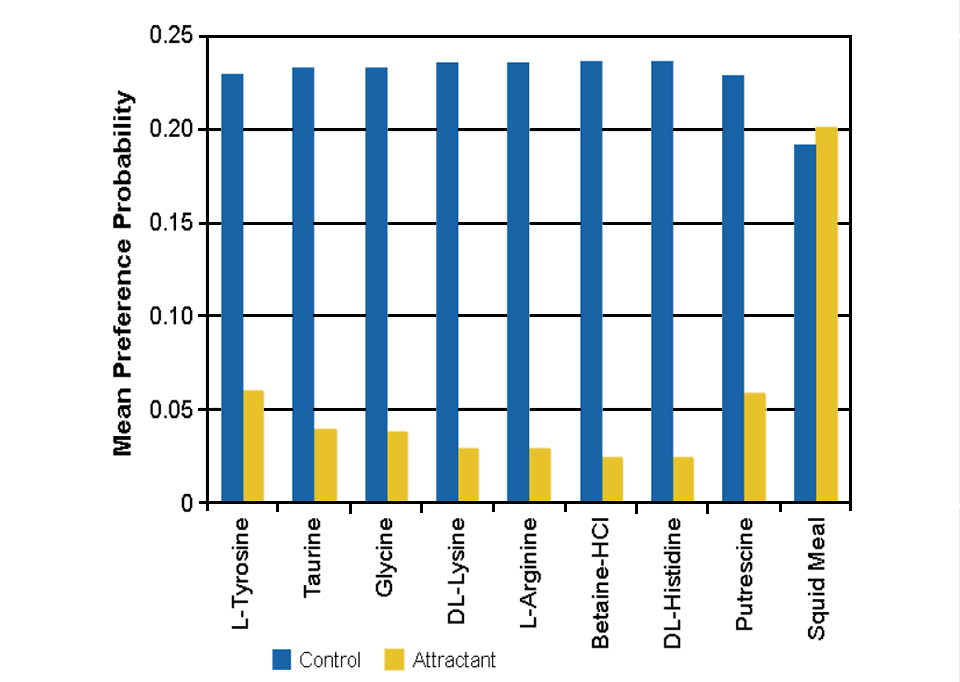
Health & Welfare
Chemoattraction of low-molecular-weight compounds in shrimp feeds
The methodology used in a Texas Agricultural Experiment Station study provided a useful tool for evaluating the attractiveness of individual ingredients in prepared shrimp feeds.
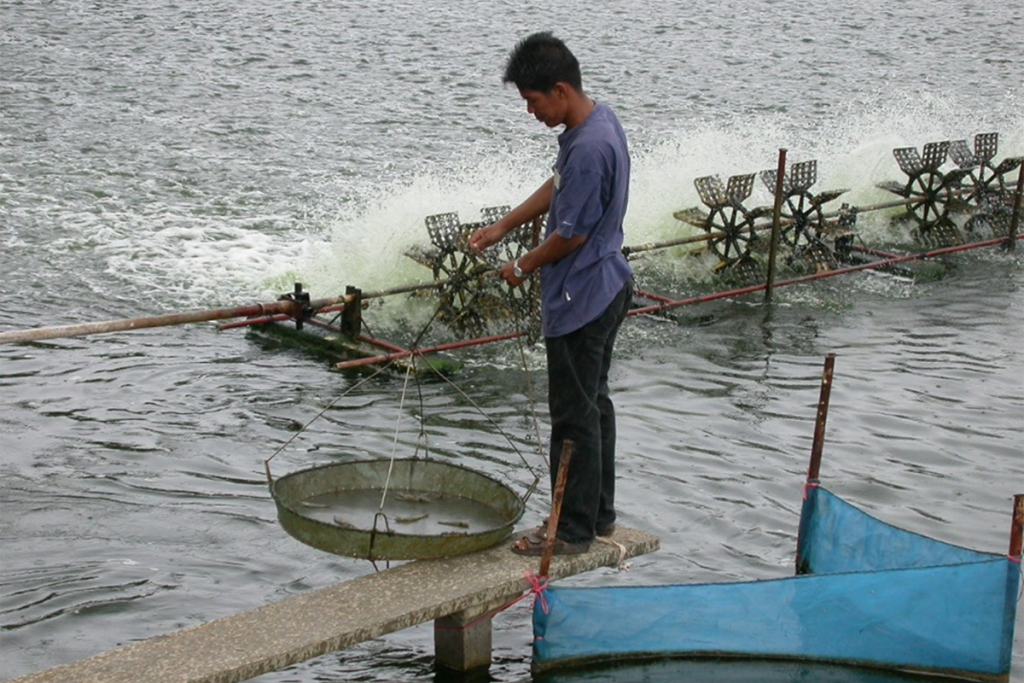
Health & Welfare
Can dietary inclusion of montmorillonite clay help mitigate the farmed shrimp AHPND pandemic?
A commercial montmorillonite clay may help protect L. vannamei against production and economic losses from AHPND outbreaks in shrimp farms.
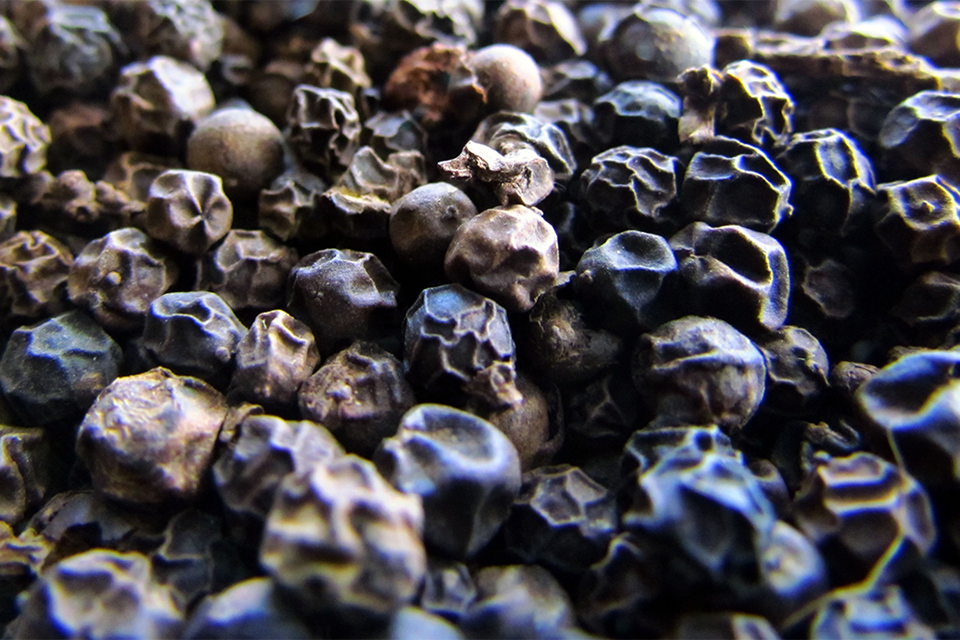
Health & Welfare
Effect of dietary piperine supplementation on production and health of Pacific white shrimp postlarvae
Piperine at doses of 0.1–0.4 percent can be a valuable feed additive to improve the growth, feed utilization, immunity, digestibility and disease resistance of L. vannamei.



